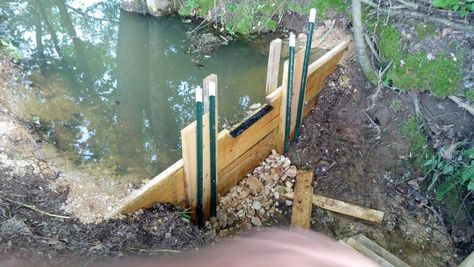Damming a pond can be a useful technique for various purposes, such as creating a water reservoir, preventing erosion, or establishing a fish habitat. In this guide, we will walk you through the steps involved in damming a pond effectively. Follow these instructions carefully to ensure a successful outcome.

Credit: www.sccdistrict.com
Step 1: Planning and Preparation
Before you start the damming process, it is crucial to plan and prepare adequately. Assess the site where you intend to build the dam, considering factors such as water flow, soil type, and the desired size of the pond. Obtain any necessary permits or approvals from local authorities before proceeding.
Step 2: Clearing the Area
Clear the area where the dam will be constructed, removing any vegetation, rocks, or debris that may interfere with the construction process. Ensure that the ground is level and compacted to provide a stable foundation for the dam.

Credit: extension.msstate.edu
Step 3: Choosing the Right Materials
Select high-quality materials for building the dam, such as clay, compacted soil, or geotextile fabric. These materials should be able to withstand water pressure and prevent seepage effectively. Consult with a professional if you are unsure about the best materials to use.
Step 4: Building the Dam
Start building the dam by laying the chosen materials in layers, compacting each layer thoroughly to ensure a solid structure. Pay attention to the height and width of the dam, ensuring that it is sufficient to contain the desired water volume without overflowing.
Step 5: Installing Drainage Systems
Include drainage systems in the dam design to control water levels and prevent flooding. These systems can consist of pipes, spillways, or valves that allow you to regulate the flow of water in and out of the pond as needed.
Step 6: Sealing and Reinforcing the Dam
Seal any gaps or cracks in the dam to prevent water from seeping through and weakening the structure. Reinforce the dam with additional layers of material if necessary to enhance its stability and durability over time.
Step 7: Monitoring and Maintenance
Once the dam is completed, monitor its performance regularly to ensure that it is functioning as intended. Inspect the dam for any signs of erosion, leakage, or damage, and make repairs promptly to prevent potential failures.
Benefits of Damming a Pond
Damming a pond can offer various benefits, such as:
- Creating a reliable water source for irrigation or livestock
- Enhancing wildlife habitat and biodiversity
- Preventing soil erosion and sedimentation
- Improving the aesthetic appeal of the landscape
- Supporting recreational activities such as fishing or boating
Conclusion
Damming a pond is a rewarding project that can have long-lasting benefits for both the environment and the community. By following the steps outlined in this guide and paying attention to detail, you can successfully dam a pond and enjoy the advantages it brings. Remember to prioritize safety and sustainability throughout the process to ensure a successful outcome.


